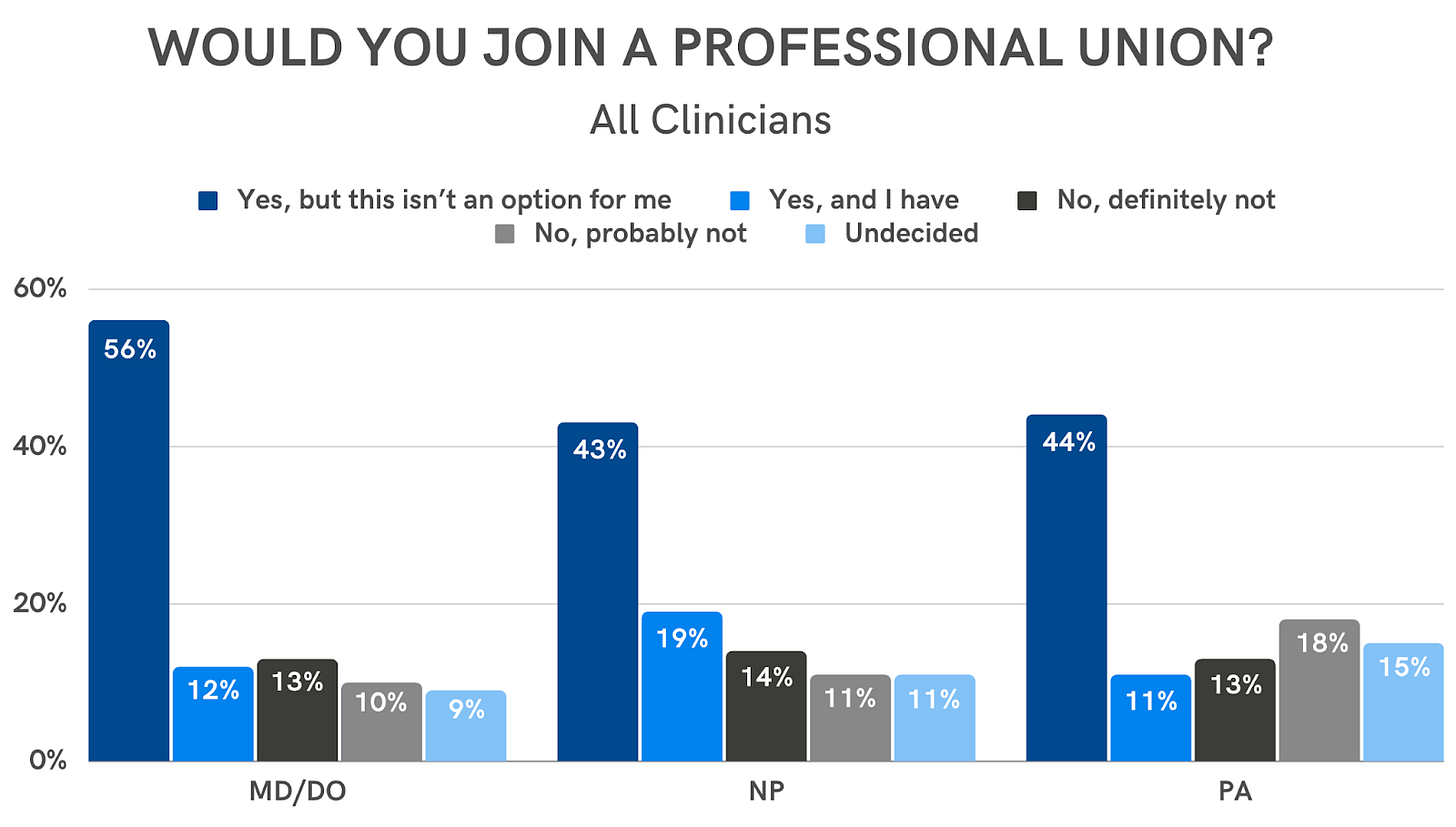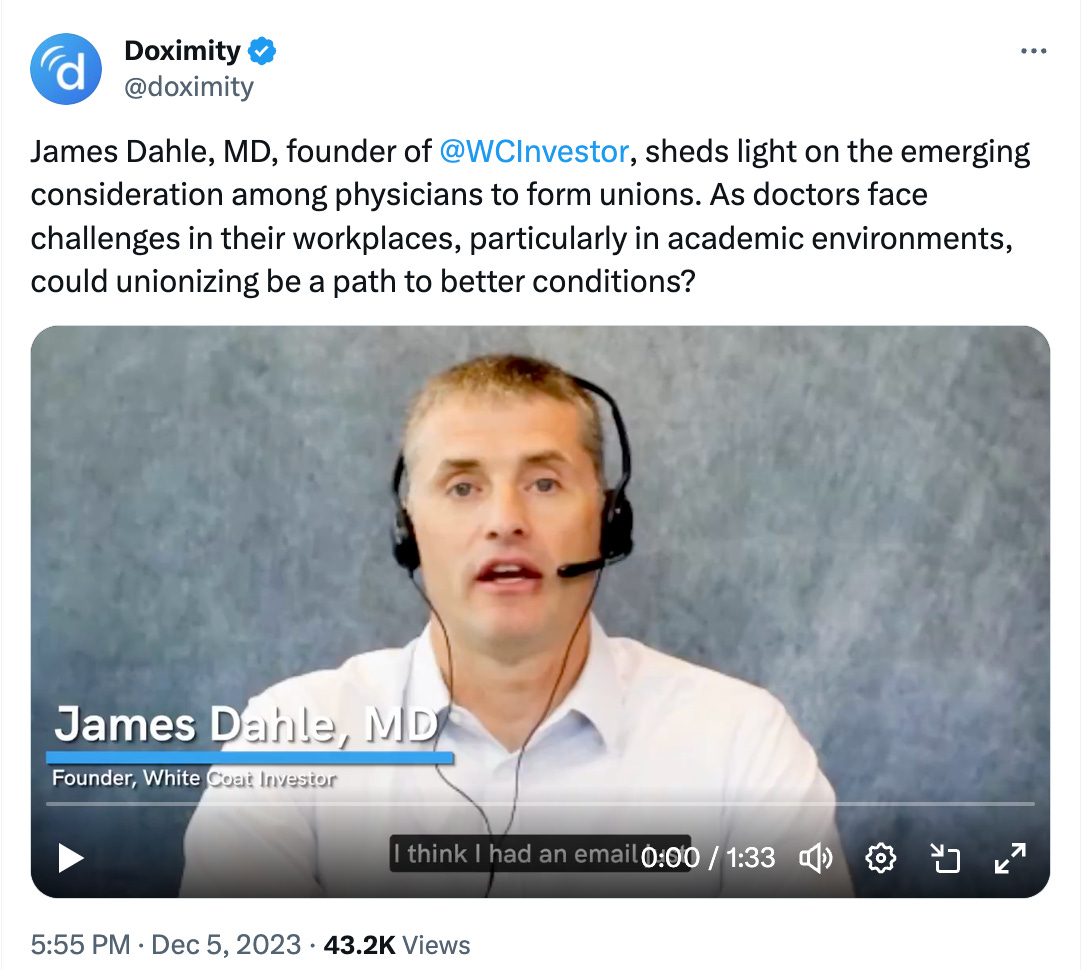Physician Unionization is So Hot Right Now
What every emergency physician should know about unions in the US.
As Will Farrell would say, unions are so hot right now. Due to emergency physicians’ deteriorating working conditions, many are exploring unionization. What you need to know:
Unions protect their members from getting fired when they advocate for improved working conditions. US Department of Labor:
“There are decades of evidence ‘demonstrating that workers are more likely to exercise rights in the presence of a labor union,’ and one reason is that union-negotiated job protections empower workers to raise workplace concerns and report violations. Union-negotiated collective bargaining agreements advance the enforcement of federal labor and employment laws by providing workers with job security through the adoption of just cause standards for disciplinary actions, including termination. Under a just cause standard for discipline or termination, included in most collective bargaining agreements, employers can only fire workers for well-documented cases of poor performance, misconduct, or other legitimate business reasons. Scholars maintain that these protections explain why unionized workers are more likely to report violations of health and safety issues—among other workplace violations—than non-unionized workers. Unionized workplaces with just cause standards for discipline or termination offer greater protections for workers reporting violations of law by providing fair disciplinary processes through a grievance and arbitration system, requiring employers to document all disciplinary decisions, and thereby limiting employers’ ability to disguise retaliatory firings as lawful employment decisions.”
Collective bargaining generally leads to better contract terms for workers than they can negotiate for themselves. US Department of the Treasury:
“While simple comparisons of the wages of union workers and nonunion workers find that union workers typically make about 20 percent more than nonunion workers, economists turn to other types of analysis to capture the causal effects of unions on wages. The first approach controls for many worker and occupation characteristics with the goal of comparing the wages earned by two similar workers that differ only in their union status. The other empirical approach is ‘regression discontinuity analysis,’ which compares the wages in workplaces that just barely passed a vote to unionize against wages in workplaces that barely failed to pass the unionization vote. All in all, the evidence from these two approaches points to a union wage premium of around 10 to 15 percent, with larger effects for longer-tenured workers.”
Physician unions increase their members’ negotiating power - not only with their medical group employer, but also with the hospital. This power stems from “joint employer” rules.
Per the National Federation of Independent Businesses, “If two businesses are joint employers under the NLRA, both must bargain with the union that represents the jointly employed workers, both are liable for unfair labor practices, and both are subject to union picketing during a labor dispute.”
The University at Buffalo resident physician union has demonstrated the power of negotiating with their hospital even though it does not directly employ them.
Physicians who are partners in a “democratic” group cannot unionize. Only employees can unionize. Owner-partners are not considered employees.
When faced with strong physician unions, hospital administrators in the future may choose to contract with physician partnerships over non-physician-owned practices, as a partnership would lead to disbanding the physician union at their facility.
Hospitals cannot eject a union simply by switching between non-physician-owned practices (eg: from SCP to TeamHealth) due to the “successorship doctrine.” Jones Day Law Firm:
“The National Labor Relations Board's successorship doctrine obligates a purchaser/new employer in an asset transaction to recognize and bargain with the union representing a seller's employees if the new employer: (i) continues its predecessor's business in substantially unchanged form, and (ii) hires predecessor employees as a majority of its post-closing workforce.”
Independent contractors can unionize if they meet the “common law agency test,” which most independent contractor emergency physicians (except locum tenens) will meet. The National Employment Law Project explains:
“In determining whether workers are covered employees or exempt independent contractors, the Board will apply a fact-specific, multi-factor test. As Atlanta Opera lays out, the Board will focus on the following eleven factors, with no one factor weighing more than others: the extent of control the employer can exercise over the work; whether or not the worker is engaged in a distinct occupation or business; whether this kind of work is usually done under the direction/supervision of the employer or by a specialist without supervision; the skill required in the work; whether the employer or worker supplies the “instrumentalities” tools, and place of work; the length of time the worker is employed; the method of payment—whether by time or by the job; whether or not the work is part of the regular business of the employer; whether or not the parties believe they are creating an independent contractor relationship; whether the employer is or is not in business; and whether the evidence tends to show that the worker is, in fact, rendering services as an independent business.”
Employees with stock options or ownership plans - for example, most US Acute Care Solutions employees - can unionize. ESOP Partners:
“In the U.S., union-represented workers earn more than non-union peers of similar education, occupation, and experience. Their advocacy has raised women’s wages and reduced wage gaps related to race and ethnicity. Unions often push for changes that improve workplace health and safety. None of these values are at odds with employee ownership. In fact, a Rutgers study reported that majority-owned ESOP companies outperformed peers at job retention, maintaining hours and salaries, and providing protective measures during the pandemic crisis. In fact, ESOPs have been directly supported by trade unions as a means to support business continuity and job stability for employees at the time of ownership transition. In short, unions supported an ESOP sale when they saw it could help protect and preserve good jobs. In other cases, owners of closely held businesses that were host to collective bargaining agreements saw including all employees in the ESOP as a powerful way to align goals across the organization.”
Most emergency physicians are eligible to join a union, as they are employees or independent contractors who meet the “common law agency test.” AMA data:
Doctors can strike - as long as they give ten days’ notice. Per the NLRB:
“Section 8(g)—Striking or Picketing a Health Care Institution Without Notice. Section 8(g) prohibits a labor organization from engaging in a strike, picketing, or other concerted refusal to work at any healthcare institution without first giving at least 10 days’ notice in writing to the institution and the Federal Mediation and Conciliation Service.”
Most physician unions in the US include physician assistants and nurse practitioners in their “community of interest” bargaining unit. Frost Brown Todd Attorneys:
In Piedmont Health Services, Inc. and Piedmont Health Services Medical Providers United, the NLRB “found that the proposed unit was appropriate because the physicians shared a ‘community of interest’ with other healthcare personnel (nurse practitioners, certified nurse midwives, and physician assistants) because they were all integrated with one another, shared common supervisors, and used similar skills to perform nearly identical work while providing healthcare services to their patients. Thus, the physicians were properly included with other healthcare personnel to constitute an appropriate unit for the election.”
Resident physician unions are expanding and winning.
For example, residents at Elmhurst Hospital in Queens, NY, went on strike earlier this year. The resulting contract included “wage increases of 18% over three years, retroactive to November 2022, a $2,000 ratification bonus, an enforceable agreement to negotiate on hazard pay, a meal allowance that reaches parity with Mount Sinai Hospital residents, and the creation of a transportation committee.”
Unions can structure employment contracts to incentivize excellence.
For example, the NFL Players’ collective bargaining agreement includes the following simple checklist for a team to terminate a football player:
Unions have the right to access a large amount of workplace information from their employer that individual employees would otherwise be unable to access. Proskauer:
Category 1: This category should include information that concerns the terms and conditions of employment of the employees working in the bargaining unit. This information is ‘presumptively relevant’ and the employer must turn it over in most cases. Generally, this information is maintained and accessible to the employer. Such information includes information about bargaining unit members, such as: Names, addresses, and telephone numbers; Dates of hire and seniority dates; Shifts and schedules; Hours worked, including overtime; Compensation, wages, and bonuses; Classifications and job titles; Performance reviews; Attendance records.”
Most US physicians would join a union if they could.
Per Doximity, “Amid a growing call for better working conditions in health care, a recent Doximity poll showed that 64% of clinicians who responded are willing to join a union. The poll included responses from more than 1,600 physicians, PAs, and NPs in November 2022. The majority of clinicians in each of these professions say they would join a union.”
Emergency medicine does not yet have a specialty-specific union in the United States. Current unions that include physicians are the Doctors Council (SEIU), Committee of Interns and Residents (SEIU), Union of American Physicians & Dentists, and American Association of University Professors.
Even the White Coat Investor thinks unions can be a positive force for physician empowerment:











This is what I’ve hoped for as an EM physician since residency in the ‘90’s. It’s unfortunately too late for me now as my career was ruined and ended by unfair contract administrators. It is truly the future of a fair playing field for most, if not all physicians today. Private practice has become a thing of the past.